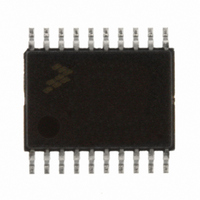MC9S08EL16CTJ Freescale Semiconductor, MC9S08EL16CTJ Datasheet - Page 178

MC9S08EL16CTJ
Manufacturer Part Number
MC9S08EL16CTJ
Description
MCU 16KB FLASH SLIC 20TSSOP
Manufacturer
Freescale Semiconductor
Series
HCS08r
Datasheet
1.DEMO9S08EL32.pdf
(356 pages)
Specifications of MC9S08EL16CTJ
Core Processor
HCS08
Core Size
8-Bit
Speed
40MHz
Connectivity
I²C, LIN, SCI, SPI
Peripherals
LVD, POR, PWM, WDT
Number Of I /o
16
Program Memory Size
16KB (16K x 8)
Program Memory Type
FLASH
Eeprom Size
512 x 8
Ram Size
1K x 8
Voltage - Supply (vcc/vdd)
2.7 V ~ 5.5 V
Data Converters
A/D 12x10b
Oscillator Type
External
Operating Temperature
-40°C ~ 85°C
Package / Case
20-TSSOP
Processor Series
S08EL
Core
HCS08
Data Bus Width
8 bit
Data Ram Size
1 KB
Interface Type
SCI, SPI, I2C, SLIC
Maximum Clock Frequency
200 KHz
Number Of Programmable I/os
16
Number Of Timers
2
Operating Supply Voltage
5.5 V
Maximum Operating Temperature
+ 85 C
Mounting Style
SMD/SMT
3rd Party Development Tools
EWS08
Development Tools By Supplier
DEMO9S08EL32AUTO, DEMO9S08EL32
Minimum Operating Temperature
- 40 C
On-chip Adc
10 bit, 12 Channel
For Use With
DEMO9S08EL32 - BOARD DEMO FOR 9S08 EL MCUDEMO9S08EL32AUTO - DEMO BOARD EL32 AUTO
Lead Free Status / RoHS Status
Lead free / RoHS Compliant
- Current page: 178 of 356
- Download datasheet (9Mb)
Inter-Integrated Circuit (S08IICV2)
11.4.1.8
The clock synchronization mechanism can be used as a handshake in data transfer. Slave devices may hold
the SCL low after completion of one byte transfer (9 bits). In such a case, it halts the bus clock and forces
the master clock into wait states until the slave releases the SCL line.
11.4.1.9
The clock synchronization mechanism can be used by slaves to slow down the bit rate of a transfer. After
the master has driven SCL low the slave can drive SCL low for the required period and then release it. If
the slave SCL low period is greater than the master SCL low period then the resulting SCL bus signal low
period is stretched.
11.4.2
For 10-bit addressing, 0x11110 is used for the first 5 bits of the first address byte. Various combinations of
read/write formats are possible within a transfer that includes 10-bit addressing.
11.4.2.1
The transfer direction is not changed (see
each slave compares the first seven bits of the first byte of the slave address (11110XX) with its own
address and tests whether the eighth bit (R/W direction bit) is 0. More than one device can find a match
and generate an acknowledge (A1). Then, each slave that finds a match compares the eight bits of the
second byte of the slave address with its own address. Only one slave finds a match and generates an
acknowledge (A2). The matching slave remains addressed by the master until it receives a stop condition
(P) or a repeated start condition (Sr) followed by a different slave address.
After the master-transmitter has sent the first byte of the 10-bit address, the slave-receiver sees an IIC
interrupt. Software must ensure the contents of IICD are ignored and not treated as valid data for this
interrupt.
11.4.2.2
The transfer direction is changed after the second R/W bit (see
acknowledge bit A2, the procedure is the same as that described for a master-transmitter addressing a
slave-receiver. After the repeated start condition (Sr), a matching slave remembers that it was addressed
before. This slave then checks whether the first seven bits of the first byte of the slave address following
Sr are the same as they were after the start condition (S) and tests whether the eighth (R/W) bit is 1. If there
is a match, the slave considers that it has been addressed as a transmitter and generates acknowledge A3.
The slave-transmitter remains addressed until it receives a stop condition (P) or a repeated start condition
(Sr) followed by a different slave address.
178
S
10-bit Address
Table 11-10. Master-Transmitter Addresses Slave-Receiver with a 10-bit Address
Slave Address 1st 7 bits
Handshaking
Clock Stretching
Master-Transmitter Addresses a Slave-Receiver
Master-Receiver Addresses a Slave-Transmitter
11110 + AD10 + AD9
MC9S08EL32 Series and MC9S08SL16 Series Data Sheet, Rev. 3
R/W
0
A1
Table
Slave Address 2nd byte
11-10). When a 10-bit address follows a start condition,
AD[8:1]
Table
A2
Data
11-11). Up to and including
A
...
Data
Freescale Semiconductor
A/A
P
Related parts for MC9S08EL16CTJ
Image
Part Number
Description
Manufacturer
Datasheet
Request
R
Part Number:
Description:
Manufacturer:
Freescale Semiconductor, Inc
Datasheet:
Part Number:
Description:
Manufacturer:
Freescale Semiconductor, Inc
Datasheet:
Part Number:
Description:
Manufacturer:
Freescale Semiconductor, Inc
Datasheet:
Part Number:
Description:
Manufacturer:
Freescale Semiconductor, Inc
Datasheet:
Part Number:
Description:
Manufacturer:
Freescale Semiconductor, Inc
Datasheet:
Part Number:
Description:
Manufacturer:
Freescale Semiconductor, Inc
Datasheet:
Part Number:
Description:
Manufacturer:
Freescale Semiconductor, Inc
Datasheet:
Part Number:
Description:
Manufacturer:
Freescale Semiconductor, Inc
Datasheet:
Part Number:
Description:
Manufacturer:
Freescale Semiconductor, Inc
Datasheet:
Part Number:
Description:
Manufacturer:
Freescale Semiconductor, Inc
Datasheet:
Part Number:
Description:
Manufacturer:
Freescale Semiconductor, Inc
Datasheet:
Part Number:
Description:
Manufacturer:
Freescale Semiconductor, Inc
Datasheet:
Part Number:
Description:
Manufacturer:
Freescale Semiconductor, Inc
Datasheet:
Part Number:
Description:
Manufacturer:
Freescale Semiconductor, Inc
Datasheet:
Part Number:
Description:
Manufacturer:
Freescale Semiconductor, Inc
Datasheet:










